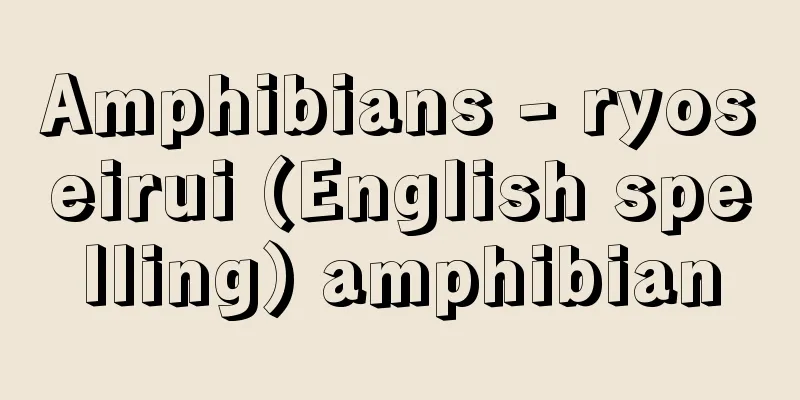Shinnai Bushi - Shinnai Bushi

|
The name of a school of Joruri. It belongs to the Bungo-bushi series and was born in Edo. The name was left by Tsuruga Wakatoshi, who later changed his name to Tsuruga Shinnai. Therefore, Fujimatsu-bushi, Tsuruga-bushi, Toyoshima-bushi, and later Okamoto-bushi and Hanazono-bushi, which are all from the same lineage, as well as Fujimatsu Joruri sung by Fujimatsu Rochu, are all collectively called "Shinnai-bushi" today. [Kiyohiro Hayashi and Yukinori Moriya] School and historyTowards the end of the Kyoho era (1716-1736), Fujimatsu Kagadayu (1686-1757), a disciple of Miyakoji Bungonojo, the founder of Bungo-bushi, travelled from Kamigata to Edo with him. After his master's death in 1745 (Enkyo 2), he changed his name to Fujimatsu Satsuma (receiving the title of Satsuma-no-jo the following year) and established a leading school of Fujimatsu-bushi. He worked at a theater until his death in 1752 (Horeki 2). Sagadayu (date of birth and death unknown) and Tsurugadayu (1717-1786) were among the waki narrators from Satsuma-no-jo's Kaga-dayu days, and the former branched off under the name Toyoshima Kunidayu, but his lineage lasted only one generation. Meanwhile, Tsurugadayu (originally called Kaga Hachi) became independent in 1751 (the 1st year of the Horeki era), and shortly after receiving the title of Asahi Wakasa no Jo, he changed his name to Tsuruga Wakasa no Jo Minamoto Yoshimasa and established his own school. However, he was overwhelmed by the skilled Tokiwazu Mojitayu I, who was plotting to enter the theater world, and in 1758 Wakasa no Jo switched to specializing in zashiki joruri. His last appearance at the theater (at the Morita-za) was played by Kaga Hachidayu (1714-1774), originally called Shinnai, who later changed his name to Shinnai (the 2nd generation). His uniquely beautiful voice was well received, and the name Shinnai-bushi came to be known as such. The Tsuruga school, including Wakasa no Jō and Shinnai, produced a series of works called hamono, which took up the double suicide cases that were common in the streets and summarized them in one volume. They told the stories using the original flavor of storytelling without being concerned with the rhythm of dance, and especially in the main Kudoki pieces, they emphasized the sensational melody, which made them well received by the common people and highly praised. Representative pieces of the time include "Rancho," "Akegarasu," and "Idahachi," which are still popular today. Two major trends stand out from the Bunka/Bunsei period (1804-1830) to the Tenpo period (1830-1844). The first was when audience tastes were no longer satisfied with the often monotonous gidayu-bushi, and they favored the more elaborate gidayu-bushi, so they enthusiastically adapted parts of popular songs and incorporated new melodies. This was during the time of Wakasa no Jō's daughter Tsurukichi I and her daughter Tsurukichi II, who was head of the school. The other was when Tsurukichi II's son Tsurukichi I, the fourth generation of the Tsuruga school, and Kaga Toshi Shinnai (Tsuruga Shinnai III), among others, began performing shinnai dance, performing as accompaniment for dance performances at Nakamura-za and other venues. As for the melody, various embellishments were added to the tone by weaving together the broad shamisen, and to make up for the monotony of the ground shamisen, the technique of uwajoshi (high pitched tone) was used in a complex and interesting way. All of this is presumed to have been due to the "shinnai nagashi" style of female shinnai, which became popular around this time. At the end of the Tenpo era, the talented Tsuruga Kaga Hattayu (1797-1861) revived the abandoned Fujimatsu school, calling himself Fujimatsu Kagadayu (later known as Rochu), and, burning with a spirit of innovation, published many elegant and sophisticated works (such as "Yugiri", "Hizakurige", "Sakura Sogo", and "Masayume") during the Ansei era (1854-60), bringing a fresh air to the new inner world. Around the same time, Azumaji Fujidayu, later known as Hanazono Ujidayu (1791?-1862), an early member of the Fujimatsu school, appeared at the three Edo theaters, but his success only lasted for a short time. Rokuchu's son, the 5th Kaga Tayu (1855-92), composed new works for "Takahashi Oden" and "Hanai Oume" in the early Meiji period, but died at a young age. The person who trained the 5th Kaga Tayu was Fujimatsu Shicho (1827-1902), a blind disciple of Rokuchu, who was renowned for his mastery of the shamisen and was a great helper to Rokuchu in composing. Yanagiya Shicho (Shicho), of the Tsuruga lineage, also studied under him and developed his own unique style of performance from the Meiji to Taisho periods. In the Meiji era, the Tsuruga school's lineage died out after the death of the 5th head, the second Wakasa Tayu, in 1891 (Meiji 24), and the following year Suzuki Jutaro, head of Tsukiji Fish Market, was recommended by the group to become head of the school, taking the name of the 6th Shinnai (later Sogen), and has continued to this day for 11 generations. On the other hand, after the death of the 5th Kaga Tayu, his brother, who took the name of the 2nd Rouchu, became the 6th head of the Fujimatsu school, taking the name Kaga Tayu, and the 7th Kaga Tayu (1856-1930) was succeeded by the 5th's pupil Fuji Tayu. His naturally beautiful voice was widely praised from the end of the Meiji era to the Taisho era, but at this time the Fujimatsu school split into the Shoha and Honha, and in later years many offshoots were born from both schools. Okamoto Bunya (1895-1996) revived the Okamoto Miyakodayu lineage, which split off from Wakasai Shinnai during the Bunka era, by changing his name from Fujimatsu Kagajidayu in 1923 (Taisho 12). In addition to traditional shinnai pieces, Okamoto Bunya released works such as "All is Well on the Western Front" from around 1930 (Showa 5), and gained a reputation as "red shinnai" and "left-wing shinnai." Currently, there are 27 groups that claim to be officially recognized among the group, and with the establishment of the Shinnai Association in 1959 (Showa 34), the group is thriving in the Japanese music world. [Kiyohiro Hayashi and Yukinori Moriya] FeaturesThe basic form of Shinnai-bushi is the endmono style, and the main part of the song, the kudoki section, continues more gently and gracefully than other styles. The melancholy melody called Ureigakari, which is often used at the beginning, becomes a more sensual melody called Ureigakari when it moves to the kudoki section. Shinnai-bushi was hardly used as a shosajitchi (accompaniment to dance dramas) in plays, so there was no formal development and it remained as a repetition of a few simple melody types from the early days. However, as the times changed, more ingenuity was put into the unique vocal technique that further increased the sense of melancholy. In addition, the higher tone of the Niagari tone, which is a replacement tone that is used to compensate for the monotony of the ground shamisen in the honcho style, was further refined in the playing technique for the "nagashi" style that is said to have begun in the Bunka and Bunsei periods, and was called Takane. In the "Nagashi no Shamisen" of Shinnai Nagashi, a pair of performers slowly walks down the street playing two shamisens, with the tayu playing the ji (base) and the shamisen player playing the treble. There are three types of shamisen: (1) Ordinary Hand (Mumei), (2) Chukan, and (3) Daikan. These are also used in Kabuki geza music, such as the Genjidana scene in "Kirare Yosa" and to depict the late-night scenes of downtown and brothels. Shinnai maebiki (prelude) are not composed for each song, but rather several existing maebiki with different moods are used as appropriate. A common type is the "Chukan," which is played from the tsubo of the third string's Chukan, and others include "Edo," "Suzumushi," and "Hikosan." [Kiyohiro Hayashi and Yukinori Moriya] "Collection of Michio Fujine's Posthumous Manuscripts" (1974, Dosho Publishing Association) [References] | | | | | | |Source: Shogakukan Encyclopedia Nipponica About Encyclopedia Nipponica Information | Legend |
|
浄瑠璃(じょうるり)の流派名。豊後節(ぶんごぶし)系列に属し、江戸で生まれた。その名称は鶴賀若歳(つるがわかとし)改め鶴賀新内の残したもの。したがって同系統の富士松節、鶴賀節、豊島節、後年の岡本節、花園節、さらに富士松魯中(ろちゅう)が唱えた富士松浄瑠璃も、今日ではすべて「新内節」の名称で総括される。 [林喜代弘・守谷幸則] 流派と沿革享保(きょうほう)(1716~36)の末年ごろ、豊後節の始祖宮古路豊後掾(みやこじぶんごのじょう)とともに上方(かみがた)から江戸へ下った門弟の富士松加賀太夫(かがたゆう)(1686―1757)は、師の没後の1745年(延享2)富士松薩摩(さつま)と改名(翌年薩摩掾を受領(ずりょう))して富士松節の一流をたて、52年(宝暦2)まで劇場に出勤して没した。この薩摩掾の加賀太夫時代からのワキ語りに佐賀太夫(生没年未詳)と敦賀(つるが)太夫(1717―86)があり、前者は豊島国太夫を名のって分派したが、1代で終わった。一方、敦賀太夫(初名加賀八)は1751年(宝暦1)に独立し、朝日若狭掾(わかさのじょう)を受領してまもなく鶴賀若狭掾源義正と改め、一派を樹立した。しかし、初世常磐津文字太夫(ときわずもじたゆう)の劇場進出をもくろむ敏腕に押され、58年には若狭掾は座敷浄瑠璃専門に転向することになったが、この劇場最後の出演(森田座)でワキを勤めたのが初名新内改め加賀八太夫(1714―74)である。そして、加賀八太夫の門人で盲人の若歳がのちに新内(2世)と改名、特異な美声が好評を博して、新内節の呼称を残すことになる。この若狭掾・新内らの鶴賀派では、巷間(こうかん)の心中事件を取り上げて一段にまとめあげた端物(はもの)と称する作品を逐次発表、舞踊の間拍子(まびょうし)にこだわらず語物本来の味を生かして語り、とりわけ眼目のクドキ地ではことさら扇情的な曲節を強調し、そのため庶民階級に迎えられて大いにもてはやされた。当時の代表曲に『蘭蝶(らんちょう)』『明烏(あけがらす)』『伊太八(いだはち)』があり、現今も流行している。 文化・文政(ぶんかぶんせい)期(1804~30)から天保(てんぽう)期(1830~44)にかけては、二つの大きな動きが目だつ。一つは、聴衆の嗜好(しこう)がとかく単調になりがちな端物に飽き足らず、筋立てのこみいった義太夫節(ぎだゆうぶし)を喜ぶ風潮から、その流行曲の一部を転用して曲節をも取り入れることを意欲的に行った。これは若狭掾の娘初世鶴吉と、その娘の2世鶴吉の家元時代のことである。もう一つは、2世鶴吉の子で鶴賀派4代にあたる初世鶴賀若狭太夫や、加賀歳(かがとし)新内(3世鶴賀新内)らが中村座ほかへ出勤して、舞踊地の伴奏を勤め、新内舞踊が行われるようになったことである。曲節のほうも、大間な三味線を縫って声調にさまざまな装飾を施したり、地の三味線の単調さを補うために、上調子(うわぢょうし)の技法も複雑におもしろく用いるようになった。これはいずれもこのころから流行してきた女(むすめ)新内の「新内流し」によるものと推定される。 天保期の末期、鶴賀派の逸材鶴賀加賀八太夫(1797―1861)が中絶していた富士松派を再興し、富士松加賀太夫(のち魯中(ろちゅう))を名のり、革新の気概に燃え、安政(あんせい)年間(1854~60)に渋く品のよい多数の作品(『夕霧』『膝栗毛(ひざくりげ)』『佐倉宗吾』『真夢(まさゆめ)』など)を発表し、新内界に清新の気を送り込んだ。また同じころ、初期富士松系の吾妻路(あづまじ)富士太夫こと後の花園宇治太夫(1791?―1862)が江戸三座に出勤したが、一時期の活躍に終わった。魯中の子、5世加賀太夫(1855―92)は明治初期に『高橋お伝』『花井お梅』の新作を手がけたが若くして没した。この5世を育成したのが魯中の高弟で盲人の富士松紫朝(しちょう)(1827―1902)で、三味線の名手とうたわれ、魯中の作曲面でのよき協力者であった。鶴賀系の柳家柴朝(しちょう)(紫朝)もこの人に学んで明治~大正期に独自の芸風を築いた。 明治に入ると、鶴賀派は1891年(明治24)5世家元の2世若狭太夫没後血脈が絶え、翌年築地(つきじ)魚市場頭の鈴木重太郎が社中から推されて家元となり、6世新内(のち祖元)を名のり、現在まで11代を数える。一方、富士松派は5世加賀太夫没後、2世魯中を襲名したその兄が6世家元となって加賀太夫を名のり、7世加賀太夫(1856―1930)は5世の門人富士太夫が継いだ。その天性の美声は明治末期から大正期にかけて広く称揚されたが、このときに富士松派は正派と本派に分裂、さらに後年、両派から多くの分派が生まれた。岡本文弥(ぶんや)(1895―1996)は、文化年間に若歳新内から分かれた岡本宮古太夫の家系を、1923年(大正12)に富士松加賀路太夫から改名して再興したものである。岡本文弥は従来の新内曲に加え、1930年(昭和5)ころより『西部戦線異常なし』などを発表、「赤い新内」「左翼新内」とよばれ評判をとった。現在、仲間内の公認と称する派は27を数え、1959年(昭和34)には新内協会の成立もあり、邦楽界のなかでも活況を呈している。 [林喜代弘・守谷幸則] 特色新内節は、端物形式が基本的形態であり、とりわけ、曲の主眼であるクドキの部分が他流に比して嫋婉(じょうえん)えんえんと続く。その冒頭部分によく用いられるウレイガカリという哀愁の曲節は、クドキに移ると一段と凄艶(せいえん)さを増すウレイという旋律型になる。新内節はほとんど芝居の所作事地(舞踊劇の伴奏)として用いられなかったため、形式上の発展がなく、初期の簡素な数種の旋律型の反復にとどまったが、時代の移行とともに悲愁をいや増す独得の発声法へと一段とくふうが凝らされた。また、本調子の地の三味線の単調さを補うための二上り調の替手風の上調子は、文化・文政期に始まったといわれる「流し」のためにさらに奏法に技巧が施されて、高音(たかね)とよばれた。2人1組の二挺(ちょう)三味線で街頭をゆっくり歩きながら奏する新内流しの「流しの三味線」は、通常は太夫が地、三味線弾きは高音を受け持つ。これには、(1)普通の手(無名)、(2)中甲(ちゅうかん)、(3)大甲(だいかん)の3種があり、歌舞伎(かぶき)の下座(げざ)音楽にも取り入れられて、『切られ与三(よさ)』の源氏店(げんじだな)の場や、下町や廓(くるわ)の夜ふけの情景描写に用いられる。また新内の前弾(まえびき)は1曲ごとに作曲されるものでなく、違った気分をもつ、いくつかの既存の前弾を適宜流用する。一般的なものとしては、第三弦の中甲のつぼから弾き出す「中甲」があり、ほかに「江戸」「鈴虫」「彦三(ひこさん)」などがある。 [林喜代弘・守谷幸則] 『『藤根道雄遺稿集』(1974・同書刊行会)』 [参照項目] | | | | | | |出典 小学館 日本大百科全書(ニッポニカ)日本大百科全書(ニッポニカ)について 情報 | 凡例 |
<<: Endocarditis - Endocarditis
>>: Jinnah - Muhammad Ali Jinnāh
Recommend
ṣaḍdarśana (English spelling) saddarsana
…the Sanskrit word śadāśana (ṣaḍdarśana) is a tra...
Uchibashitana - Uchibashitana
…The articles in the “Records of Famous Paintings...
German Theater (English: Deutsches Theater)
A representative German theater located in the ce...
Forensic psychology - saibanshinrigaku (English spelling) court psychology
It is one of the applied fields of psychology that...
Wooden door - Itatobira
...In the Zen style, the perimeter is made up of ...
Gold tip
...It is said that a follower of this sect called...
Street performance - daidōgei
It is a general term for street entertainment in ...
Numa (English spelling) Numa Pompilius
The second king of ancient Rome. Reigned 715?-673?...
Usa [city] - Usa
A city in the north of Oita Prefecture. It was inc...
Dokushi Hokyo Journal - Dokushi Hokyo Journal
This is a 130-volume historical geography book wr...
Bullen, KE (English spelling) BullenKE
...When such calculations are performed for a sta...
Lerista karlschmidti (English spelling) Leristakarlschmidti
...For example, the southern European long-legged...
shoe flower
…In Okinawa, it is used as a garden tree or hedge...
Kingstown - Kingstown (English spelling)
It is the capital of St. Vincent and the Grenadin...
Cow play - Gyugi
...People also visit the graves of their ancestor...









